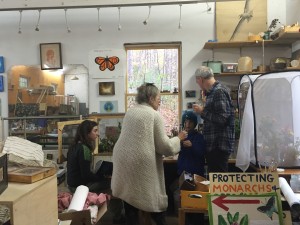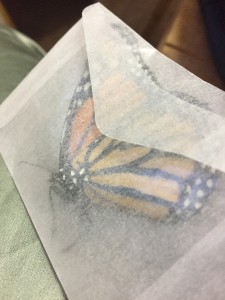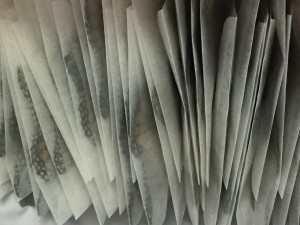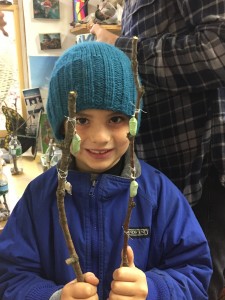
October 31, 2016
I released 48 monarchs and brought 12 chrysalids from Shokan, N.Y. to San Antonio Botanical Gardens to allow them to fulfill their destiny: migrate to Mexico and, hopefully, mate and reproduce.
Here’s how this excellent adventure and journey came to pass:
On October 22nd, Roberta Ziembra, an art teacher who lives near me, called and asked if I could help. She brought me 6 monarchs, whose late caterpillars she had found while picking apples with her family. The next day, I got an email from two women, Katherine Kelly and Krista Richards who had found many late caterpillars and asked the same question. They brought me about 23 monarchs and 23 chrysalids in a well made wood net crate enclosure.
What to do? That is twice as many monarchs than I had seen all summer.
I called head entomologist of the Dept. of Agriculture, Dr. Wayne Wehling, and asked if I could get a permit to transport the butterflies in a few days; it usually takes months.
I called San Antonio Botanical Gardens and spoke to Bob Brackman, the Executive Director. He kindly agreed to host a ceremonial release.
I spoke to Dr. Lincoln Brower about proper transport.
I called Southwest Airlines since they had flown me and one late monarch to San Antonio four years ago. They called back and said they would do it and were to get back to me by Thursday of last week. They didn’t call again, so I bit the bullet and bought a ticket. Another individual paid for my hotel.
It was 86 degrees in San Antonio and the Botanical Gardens were lush, filled with amazing blossoms and seemingly thousands of various species of butterflies, including monarchs, even though most monarchs had already headed south, the lingering ones will fatten up on nectar and soon follow suit.
I released 48 monarchs in a lovely ceremony. We hung the 12 chrysalids in the trees, tying yarn on either end of the branches which held them and hanging them, like a swing, in a flowering honeysuckle, so that it
looked like a fairy bush.
Two monarchs emerged on my way to the airport and were too wet to put in envelopes, so they spent the trip in a little insulated bag within a larger insulated bag and survived. It was interesting at the airport. Even though I had the permit and a SWA employee walked me through security, I was thoroughly searched, including a full body pat down. You know how dangerous Butterfly people are.
The butterflies and I arrived safely and there was a beautiful ceremony to release them.
Here are some photos of the beginning of the journey: The first, in my studio with my helper, my goddaughter, Sophie, a monarch in a glassine envelope, monarchs packed together, my godson, Ian, holding branches with chrysalids:
This is what I said at the ceremony:
October 31, 2016
I would like to thank San Antonio Botanical Gardens for providing a beautiful nectar rich environment in which to release these fifty amazing monarchs.
I am proud and delighted to be in a city that protects pollinators, no wonder I feel right at home here.
My little town of Olive, population 5,000, in the Catskill mountains of upstate N.Y., voted to protect pollinators at my urging in 2014 and has pollinator gardens in front of the town library and meeting hall.
In fact, we are very much connected on the continuum and what unites us is this incredible creature, the monarch butterfly.
From my modest 3 acres, a National Wildlife Federation certified wildlife backyard habitat since 2005, and monarch waystation #20, we arrive here, these late lingering butterflies and I.
Exactly four years ago I brought one late monarch here to continue her migration. I thought it was an aberration. Now 4 years later there are 50 late monarchs, which is more than Dr. Lincoln Brower, the world’s leading monarch scientist, and Dr, Wayne Weyling, head entomologist of the Dept. Agric. and I have seen combined this summer in the Northeast. There were hardly any monarchs in the N.E. this summer.
It was a balmy autumn in the N.E., global warming in action, which is affecting all living creatures, these monarchs among them.
We all have to be champions in our own way to save not only our beloved monarchs, but all pollinators.
I’ve always thought the monarchs were inspiring us to save them while guiding us to save our planet and ourselves.
When I first found one of the 13 mountains where the monarchs overwinter in Mexico in 1977 after a two month search, there were about 50 million monarchs mating on the 1st day of spring, an aerial pas de deux, an eternally graceful dance. I’ve been going every year since then and yes, the population fluctuates, 30 million to over 100 million on the mountain Cerro Pelon, for example.
Two years ago I went to celebrate the 100th birthday of dear woman who lives in a little pueblo in the shadow of the butterflies and when I hiked up to visit the monarchs, I was beyond dismayed to see that there were about 3 million covering about 40 trees on one acre. When I lived among the monarchs in ’78 and ’79, they covered thousands of trees on about 50 or 60 acres.
For as far back as anyone can remember, the monarchs arrived in the mountains on Nov. 1st. The mtn people have told me that you couldn’t see the sky for three days for the sky would be so filled with them.
I just spoke with my co-madre, the mother of my godchildren in this little pueblo of Macheros, and the monarchs are trickling in. For the past couple of years, they have arrived a week or two late. They always started arriving on Nov. 1st, El Dia de Muerto, and as the shaman Maria Sabina told me, the monarchs are the old souls of Mexico returning to the sacred mountains.
They used to depart in mid- April, and now they leave for their northward migration by mid March. Global warming is affecting all life on our beautiful planet. Monarchs are one of the canaries in the coal mine, let us not let them disappear, go the way of the carrier pigeon and the chestnut tree.
We all have our part to play, individual, communities, towns, cities and nations. Thanks to Michelle Obama, there is now a pollinator garden next to the vegetable garden on the White House lawn. To ensure that the next resident of the White House will not dismantle it, as Ronald Reagan dismantled solar panels put in by Jimmy Carter, she has put in stone paths, plaques, and benches and established an endowment of 250 million dollars for its upkeep, privately funded.
Thanks to President Obama who formed an inter-agency pollinator task force that made recommendations in 2015 to protect pollinators, 3.2 million dollars was pledged to saving the once ubiquitous monarch butterfly, About 2 million Federal dollars will restore 200,000 acres of habitat from California to the Corn Belt, including 750 schoolyard habitats and pollinator gardens. Conservation efforts will focus on the I-35 corridor from Minnesota to Texas, an important route in the monarch migration.
My heart is grateful and full to know how many have been called to save the monarchs and believe me they need every advocate possible.
The challenges they are face are multiple: GMO mono culture, overuse of pesticides and herbicides, especially those containing glyphosate, perfectly green and uniform lawns, neonicitinoids, polluted water and soil, tremendous loss of habitat, to the tune of over 2 million acres/year in the U.S., and deforestation in and around the monarchs overwintering habitats.
Even though the U.N. declared these sacred mountains a World Heritage Site, logging is relentless. This past winter about 25 acres was clear cut in the middle of the once pristine and majestic Sierra Chincua, one of the major overwintering mountains.
I coordinate a Spirit of Butterflies tour to these sacred mountains, part of the proceeds goes toward reforestation in the area. www.spiritofbutterflies.com. I worked with a reforestation group for 15 years and helped plant over 6 million trees, and so many more are needed.
All this and other negative news is sometimes overwhelming, but the only antidote that I know is walk the path of positive activism that really does ripple out. The effect of a butterfly’s wing can be felt around the world, both in the negative and in the positive as well, even though the positive doesn’t always get headline news. And a positive act is voting for politicians who believe in the science of climate change.
We all have a part to play. Each one teach one. Together we can truly save the majestic monarchs and all pollinators and ultimately all life on earth.
It takes a village – I want to thank three women who brought me the very late monarchs, having rescued and nurtured the caterpillars from the wild: Roberta Ziemba, Katherine Kelly and Krista Richards.
I am truly grateful to SABG, the mayor and the city of S.A., the NWF, and all the individuals and organizations who protect monarchs, you all are my champions.
Thank you.
Now, let’s bless and wish good speed to these monarchs.




